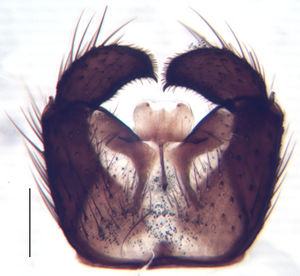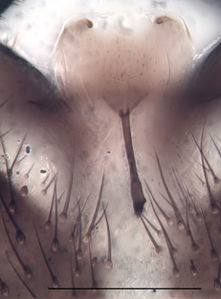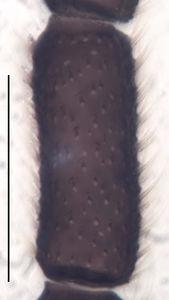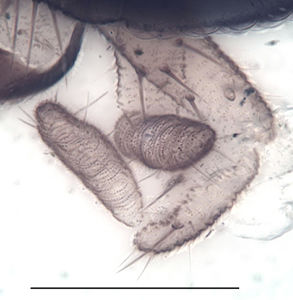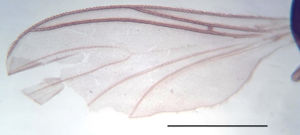Trichosiopsis nova
Ordo: Diptera
Familia: Sciaridae
Genus: Trichosiopsis
Name
Trichosiopsis nova unpublished
Type material
Holotype: ♂, 15.3.–26.4.2017, Malaise trap, leg. Kolcsár, ZFMK-TIS-2605439 in ZFMK
Type locality
Romania, Transylvania, Cluj-Napoca
Barcoded material
| Stadium | Country | Province | Locality | Habitat | Method | Date | Collector | Collection Number | Collection | Latitude | Longitude | Elevation (m) |
|---|---|---|---|---|---|---|---|---|---|---|---|---|
| 1 ♂ | Romania | Transylvania | Cluj-Napoca, Botanical Garden | Malaise trap | 15.3.–26.4.2017 | Peter Kolcsár | ZFMK-TIS-2605439 | ZFMK | 46.7603 | 23.5867 | 390 | |
| 1 ♂ | Romania | Transylvania | Cluj-Napoca, Botanical Garden | Malaise trap | 15.3.–26.4.2017 | Peter Kolcsár | ZFMK-TIS-2605441 | ZFMK | 46.7603 | 23.5867 | 390 | |
| 1 ♂ | Romania | Transylvania | Cluj-Napoca, Botanical Garden | Malaise trap | 15.3.–26.4.2017 | Peter Kolcsár | ZFMK-TIS-2605442 | ZFMK | 46.7603 | 23.5867 | 390 | |
| 1 ♂ | Romania | Transylvania | Cluj-Napoca, Botanical Garden | Malaise trap | 15.3.–26.4.2017 | Peter Kolcsár | ZFMK-TIS-2605440 | ZFMK | 46.7603 | 23.5867 | 390 | |
| 1 ♂ | Romania | Transylvania | Cluj-Napoca, Botanical Garden | Malaise trap | 15.3.–26.4.2017 | Peter Kolcsár | ZFMK-TIS-2613908 | ZFMK | 46.7603 | 23.5867 | 390 | |
| 1 ♂ | Norway | Telemark | Tokke, Lindeviki | Flight intercept trap | 10.10.2015 | Kjell Magne Olsen & Øivind Gammelmo | bf-sci-01769 | NHMO | 59.4082 | 8.2891 | 250 |
Other material studied
Sweden: 2 ♂, Öland, Skogsby, Gamla Skogsby (Kalkstad) "diversitetsängen", meadow with bushes, Malaise trap, Swedish Malaise Trap Project, 20.5.-28.06.2006, PKHH 6598/6599; 2 ♂, NHRS 2554/2643; 1 ♂, NHRS 2458.
Description (male)
Head. Eye bridge 3–5 rows of facets. Antenna unicolour. LW-index of 4th flagellomere 2.35–2.75; neck 0.15–0.23 × segment width; transition of basal part to neck pronounced. Colour of neck unicolour. Antennal setae shorter than segment width; of normal strength; dense; adjacent, or salient. Palpus darkened; long; palpomeres 3. First palpomere elongate; with 5 setae; with only sparse sensilla. Second palpomere elongate. Third palpomere as long as first. Thorax. Colour brown. Notum unicolour. Thoracic setae long and strong; black. Posterior pronotum setose. Postpronotal setae 1–5; strong. Mesothoracic sclerites bare. Legs. Colour yellow-brown. Hind coxa darkened. Setae on front coxa darkened. Front tibial organ as patch of setae; dark; front tibial organ not bordered. Tibial setae on hind legs weak and inconspicuous. Tibial spurs of equal length. Claws untoothed. Wing. Wing slightly darkened; of normal shape. Wing membrane without macrotrichia. Wing venation weak, with faint stM. M-fork of normal shape. R1 ending at or slightly before base of m-fork; posterior veins with macrotrichia; stM mostly with macrotrichia; CuA1 and CuA2 mostly with macrotrichia; bM bare; r-m with few setae, or mostly setose; bM:r-M 1.1–1.4; st-Cu:bM 0.4–0.65; R1:R 1.25–1.4; c:w 0.65–0.75. Halter dark, or darkened; of normal length. Abdomen. Abdominal setae strong; dense; on tergites black; on sternites black. Hypopygium concolour with abdomen; LW-index 0.65–0.8. Base of gonocoxites with strong setae; gonocoxites broadly separated; inner margin of gonocoxites typically U-shaped; inner membrane of hypopygium scarcely setose; ventral margin of gonocoxite with short setae. Gonostylus elongate; LW-index 2–2.3; Inner margin concave; apex equally rounded, or with one obtuse angle. Apical tooth present; without internal structure; of medium strength; LW-Index 2–3. Awl-like setae normal; beneath apical tooth absent. Megasetae absent. Whiplash-hair absent. Tegmen 0.55–0.8 × longer than broad; rectangular with rounded edges; without special features; central process absent. Length of ejaculatory apodeme/hypopygium 22–30 %; base of ejaculatory apodeme present. Field with aedeagal teeth inconspicuous. Measurements. Body size 2.8–3.6 mm. Hind tibia 1.7–2 mm. Wing length 2.8–3.4 mm.
Diagnosis
The species is placed in the Trichosiopsis rejecta group and can be distinguished from other, similar species by the combination of the following characters: strong setae at the base of the gonocoxites; weak and darkened setae at the fore coxae; gonostylus with a faint apico-dorsal angle; posterior pronotum with strong setae. One of the nearest neighbours is Tr. rejecta. Like that species and in contrast to most others of the Tr. rejecta complex the setae at the front coxa are not black, but brownish. In Tr. rejecta itself they are usually white. The gonostyli have only a faint dorso-apical angle in contrast to Tr. rejecta. By the darkened mid- and hind coxae, the shorter gonocoxites with no distinct group of fine hairs both species can be distinguished. The indistinct dorso-apical angle may lead to a misidentification as Trichosiopsis subviatica, particularly the subspecies Trichosiopsis subviatica subelongata. But here the very long first palpomere is a differential character for Tr. nova.
DNA Barcoding
The COI sequence is assigned to BIN BOLD:ADR3349 (n=1, K2P: 8.19%).
Etymology
lat. novus = new.
Discussion
Trichosiopsis nova is morphologically difficult to recognize. However, the K2P distance of of more than 8% indicates the presence of a good and distinct species. The disjunct distribution between Northern and Southern Europe is probably artificial and the species in in fact widespread in Europe.
Distribution
Norway, Romania, Sweden.
Images
|

